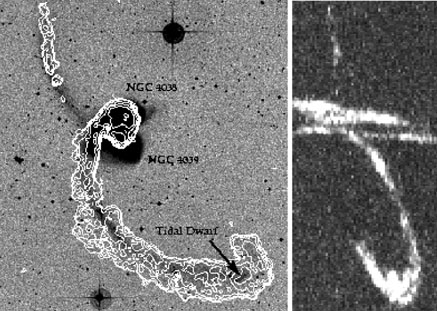

Spiral galaxies, particularly later types, tend to be rich in neutral hydrogen. Much of this gas is found in the outermost regions of the disks, which are the first regions to be perturbed during tidal interactions. As such, the structure of the gas-rich material thrown off in such encounters will bear the spatial and kinematic imprint of the encounter dynamics. Mapping the distribution and line-of-sight velocity of the atomic gas in the 21cm line of neutral hydrogen (H I) is therefore a unique and powerful tool for investigating these violent events. As an example, Figure 1 shows H I observations of the classical on-going disk-disk merger NGC 4038/9, "The Antennae". This figure emphasizes the kinematic and spatial continuity of tidal features. It is this continuity that makes H I observations so powerful for investigating on-going mergers and their evolved remnants. The tails are generally much too faint to map the stellar kinematics, and ionized emission tends to be confined to a few localized regions of star formation. H I mapping is very often the only way to obtain such information.
 |
Figure 1. VLA C+D array H I observations of NGC 4038/9 (Hibbard, van der Hulst & Barnes, in preparation). Left: In this and all subsequent figures contours indicate the integrated H I emission and greyscales the optical morphology. Right: H I position-velocity plot, with declination along the y-axis and line-of-sight velocity along the x-axis. |
At present, at least 140 on-going interactions, mergers, or merger remnants have been mapped in the 21cm line of neutral hydrogen. This includes such classes of objects as interacting doubles, major mergers, evolved merger remnants, shell galaxies, ring galaxies, polar ring galaxies, compact groups, and ellipticals with extended H I debris. In the remainder of this review I will highlight some of what we have learned from these observations. It is beyond the scope of this review to summarize the wealth of knowledge obtained on each of the more than 140 systems observed, and I will instead highlight a few global themes. For additional details, the reader is directed to the proceedings edited by Arnaboldi et al. (1997), especially the contributions by van Gorkom & Schiminovich, Morganti et al., Schiminovich et al., and Oosterloo & Iovino. See also the recent H I reviews of mergers by Sancisi (1997), of compact groups by Verdes-Montenegro et al. (1999), of ring galaxies by Appleton & Struck-Marcell (1996), and of polar ring galaxies by Sparke (these proceedings).